The Linux Vendor Firmware Service (LVFS) that goes hand-in-hand with the Fwupd open-source firmware updating utility celebrated the milestone on Wednesday of crossing 135 million firmware updates…
Google’s Homepage Has a Halloween-Themed PAC-MAN Game Right Now
Even in 2025, Google.com still knows how to have fun. If you tend to rely on your browser’s address bar for Google Search, you might miss the company’s latest “Doodle.” But today, Oct. 30, if you head to the Google homepage, you’ll find a Halloween-themed surprise: a fully playable PAC-MAN game, outfitted with spooky mazes and characters.
The Halloween part makes sense, seeing as the holiday is tomorrow. But why PAC-MAN? As it happens, this year marks the game’s 45th anniversary. For this Doodle, Google says it partnered with PAC-MAN’s parent company, Bandi Namco Entertainment, to feature a celebratory PAC-MAN game on the homepage.
If you’re familiar with PAC-MAN, you won’t have any trouble getting into Google’s version. This is the core PAC-MAN experience players have navigated since 1980: You control PAC-MAN through a maze, eating all the dots along the way. If you crash into one of the four ghosts floating around the maze (Blinky, Inky, Pinky and Clyde), you die, unless you eat an “Power Pellet,” in which case you’re free to eat the ghosts. According to Google, this game has eight levels, with four haunted-house mazes.
I do appreciate the effort that went into this experience. Sure, the PAC-MAN gameplay is the same as ever, but the Halloween-themed mazes are fun. I also love the attention to detail with the graphics: The visuals have scan-lines, which sells the retro look. You won’t be getting 4K crispy pixels in this game, and that only makes it feel like you’re back at your local arcade.
Google says the game is only available today (Oct. 30) and tomorrow (Oct. 31) from the homepage, though I would hope it will be made available elsewhere (Google Doodle games are typically archived). But if you want to give it a shot, try it out now just in case.
How to cancel Norton VPN, uninstall it and get your money back
Norton Security has some reliable products, but its VPN isn’t one of them. In my Norton VPN review, I argued that it’s only really worthwhile if you can get a discount on it as part of a Norton 360 package — and even in that case, you should only use it for non-sensitive activities due to some holes in Norton’s comprehensive privacy policy.
That’s a lot of conditions, so I’d understand if you’re here because you’ve decided Norton VPN isn’t for you. Read on to learn your options for cancelling this VPN, getting a refund and replacing it with a better provider.
How to turn off Norton VPN auto-renewal
The simplest way to cancel Norton VPN is to stop your subscription from automatically renewing. That way, you’ll have until your plan expires to look for a new VPN. Note that the steps below are the same no matter how you got Norton VPN, whether on its own or as part of Norton 360 — though they only apply if you subscribed through the Norton website, not an app store.
-
Sign into your account at my.norton.com. You’ll be taken to your account dashboard with your subscriptions tab visible. If it’s not, click on My Subscriptions.
-
On your subscriptions hub, find the plan you get Norton VPN through. Click the words Manage Renewal or Cancel Subscription Renewal.
-
In the window that appears, click Unsubscribe. Select a reason for cancellation (no need to be truthful) and click Next.
-
At this point, you’ll have to wade through several pleas for you to stay. Stand firm and keep clicking through until you can click No thanks, cancel my subscription.
-
Continue clicking Next until you see a confirmation that auto-renewal has been turned off. Wait 24 hours for the change to take effect.
If you change your mind after turning auto-renewal off, you can turn it back on again anytime before the subscription expires. For those who bought through an app store, there’s no way to turn off auto-renewal; you can only cancel the subscription altogether. See the end of the next section to learn how to do that.
How to cancel Norton VPN and get a refund
You can request a refund on any annual subscription for 60 days after paying. Monthly subscriptions can only be refunded once, within 14 days of paying — if you renew a monthly plan then decide to cancel, you’re out of luck.
The only way to get a refund is to contact Norton directly. If you’re ready to go cold turkey, follow these steps.
-
In a browser, open support.norton.com.
-
Scroll down until you see nine buttons arranged in a 3×3 grid. Find the second button down in the left-hand column, Contact us, and click on it.
-
Enter the email address for your Norton account. Check that inbox for a verification code, then enter it in the next box and click Verify.
-
When the live chat asks you what you need help with, select Purchase & Billing, then Request refund. Give a reason in the dropdown menu.
-
As usual, be persistent until you get a message in writing that your refund will be processed. Wait at least three days for the money to appear.
If you subscribed through the Apple App Store or Google Play Store, you’ll have to cancel through the same platform where you started. Just go into the subscriptions page of the store’s mobile app, find your Norton VPN subscription and click the Cancel button beside it. After that, just follow the prompts, then request a refund using the steps above.
How to uninstall Norton VPN
To get your money back from Norton, you can’t just shut off auto-renewal. You’ll have to cancel your plan immediately and delete all Norton apps from your devices. I recommend following these steps even if you aren’t eligible for a refund, since Norton software is notoriously hard to uninstall and will crop back up if you don’t completely root it out.
On Android and iOS, uninstalling Norton VPN is relatively easy — after cancelling your subscription, delete it like you would any other app. Things are a bit trickier on the desktop OSes. On Windows, hold the Windows key and press R to make a black box appear. Type appwiz.cpl and hit Enter. A list of programs should appear; click on Norton VPN, then click Uninstall/Change and follow the instructions.
On a Mac, open your Applications folder and find Norton VPN. Click the app icon and drag it to the trash. This should start a separate program called Norton Uninstaller. Click OK, enter your password if asked, then click Uninstall. Finally, you’ll need to restart your computer to finish uninstalling.
Norton VPN alternatives
Once you’ve dispensed with Norton VPN, you can get started with a provider that fits your needs better. Proton VPN, my current top pick in our guide to the best VPNs, takes privacy more seriously than Norton and has superior app design and speeds. Surfshark is the fastest VPN, NordVPN has the best features and ExpressVPN is the friendliest for beginners.
This article originally appeared on Engadget at https://www.engadget.com/cybersecurity/vpn/how-to-cancel-norton-vpn-uninstall-it-and-get-your-money-back-150000872.html?src=rss
“Green to Screen” Route Details
Did Amazon Just Kill Its Lord Of The Rings MMO?

Also: bad news for Resident Evil fans on Switch 2
The post Did Amazon Just Kill Its <i>Lord Of The Rings</i> MMO? appeared first on Kotaku.
Google To Offer Free Gemini AI Pro, 2TB Storage To India’s 505 Million Reliance Jio Users
Google will offer 18-month free access to its Gemini AI service for all 505 million telecom users of India’s Reliance Jio, a tie-up that follows similar freebies from rivals including OpenAI to boost adoption in the world’s most populous nation. From a report: The move also comes weeks after Google committed to invest $15 billion in AI infrastructure capacity in India, its biggest investment yet in the critical South Asian market.
[…] The Gemini offer will give Jio users free access to the advanced model of the AI app, two terabytes of cloud storage, and its image and video generation models, in an 18-month offering that is otherwise priced at 35,100 rupees ($399). The companies on Thursday also announced AI partnerships that targeted Indian businesses.
Read more of this story at Slashdot.
TikTok may become more right-wing as China signals approval for US sale
The US inched one step closer to taking over TikTok’s algorithm after President Donald Trump met with Chinese President Xi Jinping on Thursday.
Neither leader confirmed that China has agreed to the terms of Trump’s proposed deal, which would create a US version of TikTok that licenses the Chinese-owned algorithm. But the Chinese Commerce Ministry provided a statement following the meeting; translated, it indicates that “China will properly resolve TikTok-related issues with the United States.”
Trump, who has long vowed to “save” TikTok, was notably silent on Thursday, but US Treasury Secretary Scott Bessent told Fox News ahead of Trump’s meeting with Xi that “we finalized the TikTok agreement in terms of getting Chinese approval.” According to Bessent, the deal will “finally” be resolved over the “coming weeks and months,” Reuters reported.
US government is getting closer to banning TP-Link routers
A number of US government agencies are backing a potential move by the Commerce Department to ban TP-Link routers, according to The Washington Post. Multiple sources familiar with internal deliberations spoke with the publication on the condition of anonymity, including a former senior Defense Department official.
A months-long interagency process involving the Departments of Homeland Security, Justice and Defense took place this summer to consider the sweeping move. Investigations into the company stemming from national security concerns have been taking place since at least last year.
At the heart of the potential ban is a concern that TP-Link retains ties to China, despite splitting from Chinese corporation TP-Link Technologies to become a standalone entity in 2022. A spokesperson for TP-Link denied any Chinese ties, saying “any adverse action against TP-Link would have no impact on China, but would harm an American company.”
US officials told The Washington Post they are concerned because under Chinese law, TP-Link must comply with Chinese intelligence agency requests and may even be pressured to push malicious software updates to its devices. US-based TP-Link Systems said the company is “not subject to the direction of the PRC intel apparatus.”
TP-Link routers are among the most popular in the United States, with the company claiming 36 percent of US market share. Earlier this year however, former American cybersecurity official Rob Joyce testified before Congress that TP-Link’s market share was roughly 60 percent, thanks in part to selling its equipment below cost in order to drive out competition.
The potential ban of TP-Link products is another in a long list of bureaucratic moves or discussions that have come against the backdrop of trade negotiations between the US and China. While a potential breakthrough in these talks was achieved today, a source for The Washington Post said a ban on TP-Link products remains a bargaining chip for the administration.
This article originally appeared on Engadget at https://www.engadget.com/cybersecurity/us-government-is-getting-closer-to-banning-tp-link-routers-145528317.html?src=rss
Nintendo Was Just Dealt A Big Blow In Its Battle Against Palworld

The patents on which Nintendo is relying aren’t looking too solid
The post Nintendo Was Just Dealt A Big Blow In Its Battle Against <i>Palworld</i> appeared first on Kotaku.
LEGO Offloads Minecraft Sets, the Creeper Is Selling for Pennies on the Dollar

This iconic Creeper LEGO set drops to its lowest price ever.
The post LEGO Offloads Minecraft Sets, the Creeper Is Selling for Pennies on the Dollar appeared first on Kotaku.
The Animal Crossing Community Just Woke Up Like A Sleeper Agent

The Switch 2 edition and 3.0 update have given Animal Crossing fans something to look forward to again
The post The <em>Animal Crossing</em> Community Just Woke Up Like A Sleeper Agent appeared first on Kotaku.
The Two Best Apps to Keep Up With Your Fitness Routine While Traveling
Sticking to a workout schedule is tough even when everything is going normally and you have a pretty standard daily routine. Once you add travel into the mix, it can feel impossible. Sure, hotels have fitness centers, but if you’ve ever gone to one only to learn it’s nothing more than a few dumbbells and an ancient treadmill, you know how aggravating those can be. There are two apps I use to stick to my routine and prioritize my health while I’m on the road, but I use them quite differently.
ClassPass
After discovering last month that ClassPass houses a little-known, but varied, selection of at-home workout classes to stream, I happily re-downloaded the app for the first time in years. If you’re not familiar, you buy monthly credits that you can redeem at gyms and fitness studios, trading a handful of credits for, say, a yoga or HIIT class. (You can also use it for salon and spa services, which is a cool upgrade that app has gotten since I last used it.)
I used it all around my neighborhood in New York City for a month, checking out all the boutique studios near me, and found some I loved and others I was glad I didn’t spend full price on a trial class for. But last week, when I was home visiting my mom in North Dakota, I checked ClassPass—and sure enough, yoga, barre, spin, and Pilates classes came up. I hadn’t entirely expected it to work; it’s one thing for a well-populated location like Manhattan to have a bunch of offerings on there, but Bismarck? Yes, Bismarck! I went to a barre class and it was awesome, exactly what I needed to stay on track with my workout schedule and destress after a disastrous night of airline mishaps.
In the next three months, I’m going to West Virginia, Nebraska, and Mississippi. That’s how your vacation schedule looks when you’re on a mission to visit all 50 states (and I only have eight to go). According to ClassPass, I’ll be able to take a yoga class in Charleston, do HIIT in Omaha, and book time at a pickleball court in Biloxi. All of that beats a hotel fitness center by a mile. Even the smallest cities are well-represented on this app and you can get a real, full class experience wherever you are.
Peloton
I am a dedicated Peloton user and the app gets daily use from me, even if I’m only using it to track my outdoor walks. If you can’t find the time or transportation to get to an in-person class, you have loads of options through Peloton, many of which can be completed in your hotel room, like yoga or stretching.
There are guided walks available so you can take yourself on a mindful explorative journey around wherever you are, but you can also find loads of hotels that have Peloton cardio equipment. Usually, the Bikes or other equipment are in a fitness center, but I’ve seen hotels that even have them available in-room.
Even if you can only devote 10 minutes to working out, it’s better than nothing and keeps you in your groove, which is why I value the Peloton app so much. I did, of course, use it to track the barre class I took in Bismarck, plus the Les Mills Body Pump and Solidcore classes I took there, too.
Falling panel prices lead to global solar boom, except for the US
To the south of the Monte Cristo mountain range and west of Paymaster Canyon, a vast stretch of the Nevada desert has attracted modern-day prospectors chasing one of 21st-century America’s greatest investment booms.
Solar power developers want to cover an area larger than Washington, DC, with silicon panels and batteries, converting sunlight into electricity that will power air conditioners in sweltering Las Vegas along with millions of other homes and businesses.
But earlier this month, bureaucrats in charge of federal lands scrapped collective approval for the Esmeralda 7 projects, in what campaigners fear is part of an attack on renewable energy under President Donald Trump. “We will not approve wind or farmer destroying [sic] Solar,” he posted on his Truth Social platform in August. Developers will need to reapply individually, slowing progress.
Govee Smart LED Ceiling Light Is Going for Peanuts, Already Selling Out Fast After the Price Drop

Say goodbye to boring white lights. This smart ceiling light instantly upgrades the vibe of any space.
The post Govee Smart LED Ceiling Light Is Going for Peanuts, Already Selling Out Fast After the Price Drop appeared first on Kotaku.
YouTube Rolls Out Auto AI Upscaling For Low Quality Videos And Other Cool Features

With streaming content being watched on bigger displays than ever before, Google wants to ensure that older, lower-resolution videos (think 480p and 720p) don’t look janky on your fancy new 4K TV. YouTube is rolling out a suite of creator tools to address that and chief among them is the use of AI to breathe new life into its vast archive
In-home Helper Robot ‘NEO’ Uses Remote VR Operators to Help with Chores
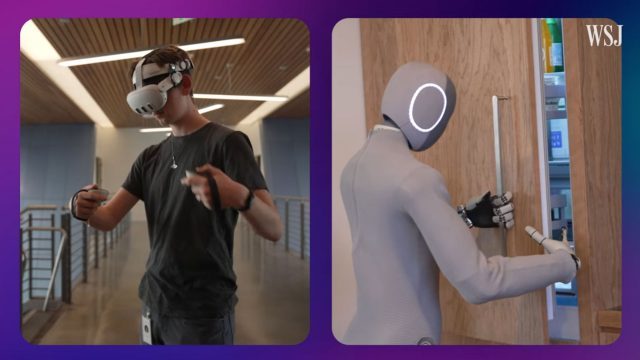
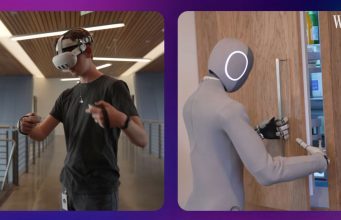
NEO is a humanoid robot from Palo Alto-based robotics startup 1X that could one day autonomously help out around your home. For now though, it’s using human operators wearing Quest 3 headsets to pick up the slack and teach Neo’s neural network the ropes in the process.
The News
The 66 pound, sweater-wearing robot doesn’t seem very capable on its own, at least for now. As Joanna Stern from The Wall Street Journal puts it in a recent interview (seen below), Neo’s neural network needs a helping hand to “learn from more real world experience,” like how to load a dishwasher, fetch a bottle of water from the fridge, or clean up the kitchen counter.
It’s doing that by looping in humans who wear VR headsets to teleoperate Neo during user-scheduled intervals in ‘Expert Mode’, which also includes a configurable list of more difficult tasks you want a Neo’s teleoperators to perform.
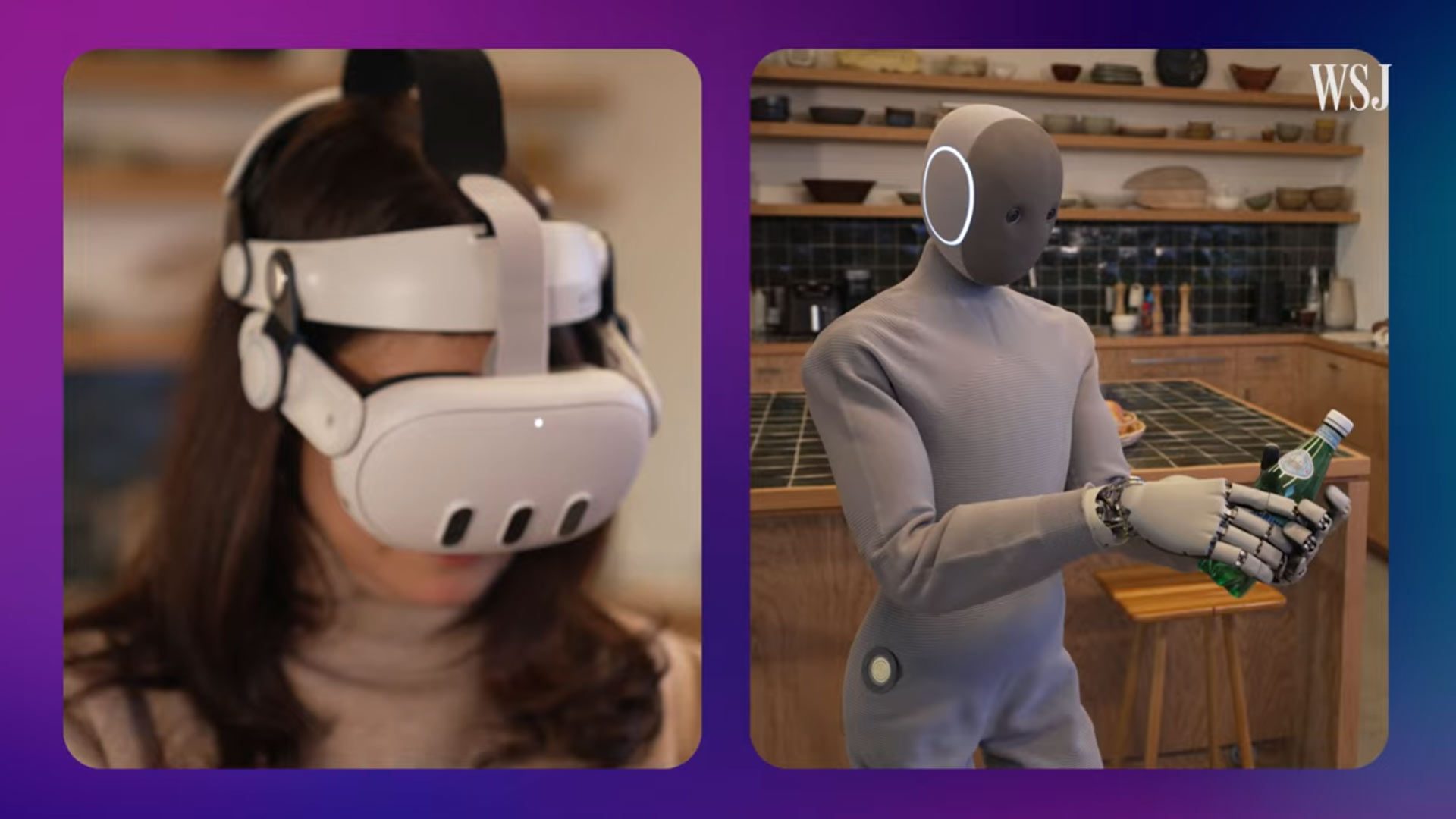
While Neo is said to be capable of numerous household tasks, it can’t pick up overly heavy items, hot things, or sharp things, 1X CEO and Founder Bernt Børnic says, which probably means it won’t be cooking a soufflé or helping you move a bedside table any time soon.
There are a few more limitations. While Neo can be limited from entering specific parts of your home, and even potentially blur out humans to preserve privacy, Børnic frames privacy concerns as a sliding scale of user permissions. The more data you give up, the better Neo can work.
“I think it’s quite important for me to just say that, in 2026, if you buy this product, it is because you’re okay with that social contract,” Børnich tells WSJ. “If we don’t have your data, we can’t make the product better. I’m a big fan of what I call like ‘big brother, big sister’ principle, right? Big sister helps you. Big brother is just there to kind of monitor you. And we are very much the big sister. Depending on how much you want to trade, we can be more useful, and you can decide where on that scale you want to be.”
Notably, during Neo’s demo with WSJ, the robot wasn’t performing any tasks autonomously. Still, Børnich says that Neo will do “most of the things in your home autonomously” when it ships next year, noting that the quality of work will “vary and will improve drastically quite fast as we get data.”
Neo is currently available to reserve for a $200 refundable fee, arriving in three different colorways; grey, taupe, and black. Neo is expected to ship in the US sometime in 2026, priced at $20,000 for outright ownership, or for a $500 monthly subscription. Watch the full demo and WSJ interview below for more:
My Take
For now, if you can afford to hire a daily maid service, you can probably afford Neo, which makes the $20,000 price tag an intriguing value proposition.
After all, there aren’t any traditional employment contracts, sick days, domestic insurance policies, or any other quality of life concerns to contend with—only a four hour battery life that can be quick charged when it runs flat. That, and you’ll probably need to launder Neo’s turtlenecked jumpsuit every once in a while.
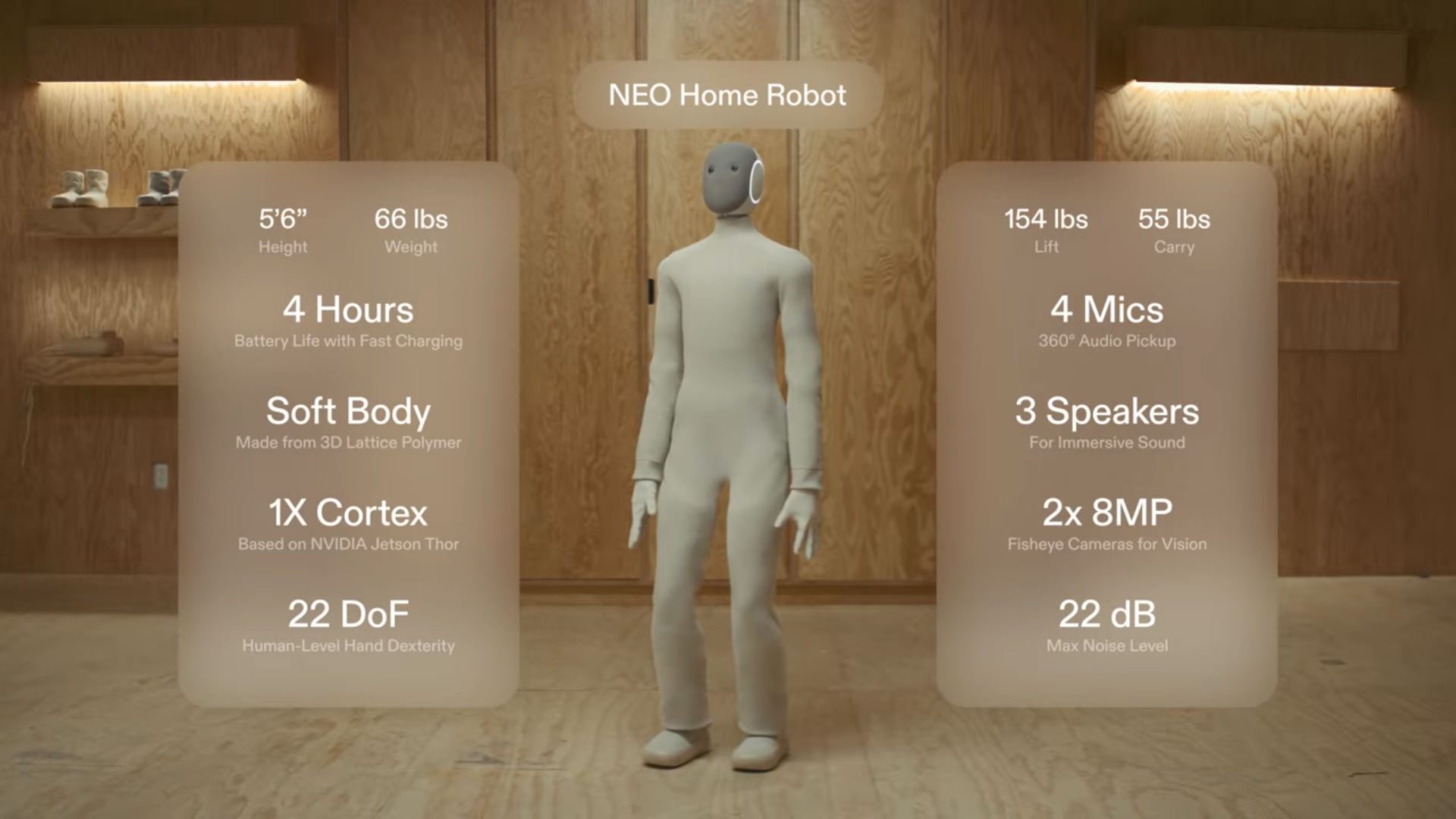
Still, I’m not so sure Neo delivers as a maid replacement quite yet, at least after watching WSJ’s demo. Even with a human controlling it, who uniquely understands how a refrigerator door works and how to fold a shirt neatly, it still struggles to do basic tasks better and faster than a human without an expensive robot body. Okay, faster isn’t exactly that important, since you can schedule tasks when you’re away.
That said, some of that initial awkwardness seen in the WSJ demo can be explained by the input method itself. As they are today, off-the-shelf consumer VR headsets like Quest 3 don’t provide the sort of proprioception you need to instantly understand that a surface is soft and pliable, or hard and fragile. An onboard neural network might, but we haven’t seen that in action yet beyond what the company’s hype video, seen below.
Let’s call it what it is: experts teleoperating Neo is a stopgap measure. As it is now, having a teleoperator use a headset and two motion controllers to guide a robot makes for some very slow and deliberate movement, as they’re likely only going on visual cues alone—a bit like trying to pour a glass of red wine when both your hands are completely numb. There’s also probably a fair bit of latency too, but if the job gets done, then you probably don’t care who did it—neural network or telehuman—or what challenges they faced along the way.
For now, I wonder how much time a teleoperator will have to spend painstakingly pouring laundry detergent into a cup, only to accidentally spill it. Does it have the dexterity to clean up the sticky mess? And what happens if it knocks over my priceless Ming vase? Or the dog takes a leak on my marble floors and Neo slips and falls, covering itself with dog piss? What sort of mess will I (or my human maids) have to contend with when I get back to my sensibly decorated villa?
Forgive the flagrant ‘rich guy’ framing above, but those are the only realistic scenarios I can muster at this stage. Whatever the case, I think it’s far too early to jump to the usual perils provided by Black Mirror, I, Robot (2004), or even Battlestar Galactica. More than anything, I think people buying Neo will more likely be asking themselves “what will my friends say when they learn I have a robot butler?” And probably not much else.
Still, there are other implications that go beyond using Neo as a walking, talking Google Nest, as neat as that may be. Provided Neo owners can connect using a Quest 3 like we see in the hype video, you might be able to telecommute back home to see where you left your keys, make sure the back door is locked, or check up on the dog to make sure they haven’t gotten into the pantry. Maybe not worth $20,000, but it’s a neat use case 1X should leverage if they haven’t already.
The post In-home Helper Robot ‘NEO’ Uses Remote VR Operators to Help with Chores appeared first on Road to VR.
ASUS ROG Claims First AI Gaming Router With Rapture BG-BE19000AI Wi-Fi 7
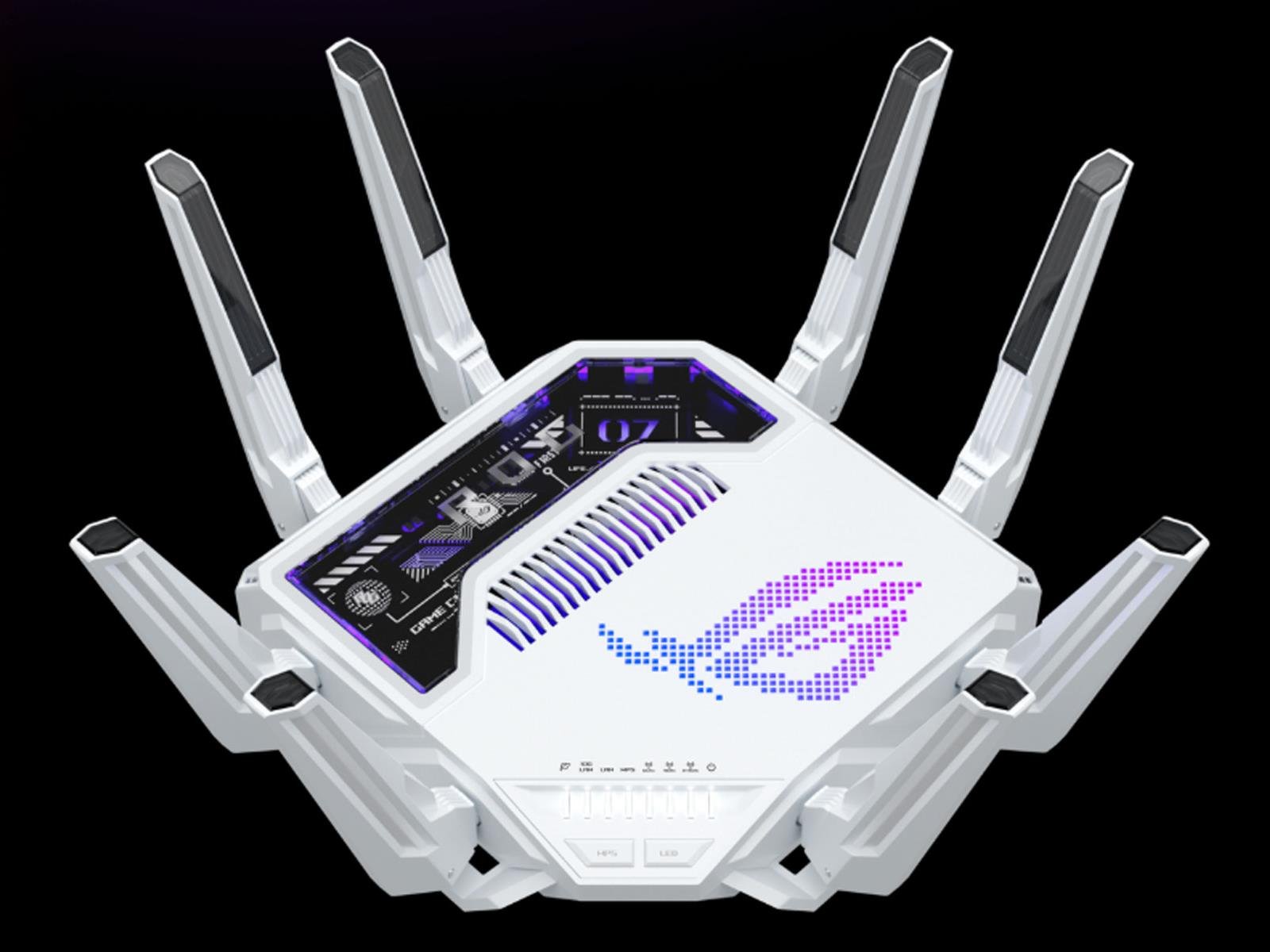
If your router isn’t using artificial intelligence in some capacity, is it really a router? The answer is yes, but be that as it may, ASUS Republic of Gamers (ROG) isn’t leaving anything to chance with its new flagship Wi-Fi 7 model for gamers, the Rapture GT-BE19000AI. Billed as the “world’s first AI gaming router,” the device sports a built-in
US and China agree to one-year pause on punitive tariffs
Donald Trump and China’s leader, Xi Jinping, have agreed to a one-year pause on the punitive Trump-instated tariffs that are at the heart of the ongoing trade war between the two superpowers. Among the issues discussed when the two leaders met face-to-face in the South Korean city of Busan were China’s chokehold on rare earth metals and the export restrictions on NVIDIA’s AI chips.
Trump had previously made some characteristically explosive threats that he would impose new 100 percent tariffs on imports from China as a retaliation to Xi’s tightening grip on rare earths, the processing of which is almost entirely controlled by China. These materials are essential for manufacturing everything from smartphones and EVs to military equipment. As part of the (for now) temporary truce, China reportedly agreed to pause the new measures for the next 12 months in exchange for Trump lowering Chinese tariffs by 10 percent.
According to The New York Times, Trump said he had discussed semiconductors during his talks with Xi, and “did not rule out” the possibility of allowing NVIDIA to sell AI chips to China. The American company was allowed to resume selling its H20 chips in China in July after an initial ban earlier in the year, only for Beijing to reportedly respond by instructing its largest tech companies not to do business until a national security review had been completed. The leaders did not discuss the possible availability of Blackwell chips — NVIDIA’s most advanced AI chip to date that is currently in development and possibly a motivating factor in China’s apparent indifference to the H20 architecture — at their meeting in South Korea.
There was also no resolution on TikTok and its future in the US. The last we heard, the Trump administration claimed to be close to agreement that would see the US gain majority ownership of the Chinese-owned social media giant where it was operating on home soil, but nothing has been finalized at the time of writing.
This article originally appeared on Engadget at https://www.engadget.com/big-tech/us—china-trade-talks-see-one-year-pause-on-punitive-tariffs-140550358.html?src=rss
Zorin 0S 18: 100,000+ Windows 10 Users Can’t Be Wrong
With performance boosts and seamless cloud connections, Zorin OS 18 is quickly becoming the top gateway for Windows refugees.
The post Zorin 0S 18: 100,000+ Windows 10 Users Can’t Be Wrong appeared first on FOSS Force.
Just Dance Now is coming to LG smart TVs
LG and Ubisoft have teamed up to bring the motion-controlled rhythm game Just Dance Now to LG Smart TVs. The game will be available from December in the LG Gaming Portal for LG TV users in the US and Europe running webOS 22 or later, with no additional hardware required.
Just Dance Now originally launched in 2014 as a mobile app for iOS and Android, before Ubisoft brought the game to Apple TV a year later. A main series spinoff aimed at people who don’t own a console, Just Dance Now offers a library of hundreds of songs that span decades of music, which you’ll be able to access for free for a limited time each day. If that just isn’t enough dancing time to satisfy you, you can subscribe to one of Ubisoft’s paid plans or purchase song packs.
Just Dance Now was originally designed to be played using your phone as a controller, with your handset of choice functioning much like the Wii Remote did in the very first Just Dance game back in 2009. In the LG Gaming Portal version of the game, the motion-sensing LG Magic Remote becomes the peripheral, so you really don’t need any extra gear.
Ahead of the December launch, the Just Dance Now app will be available in beta, allowing players to try three songs on the first day, followed by one daily for the remainder for the two-week trial. Ubisoft hasn’t announced the release date for the beta yet.
The LG Gaming Portal is gradually becoming a viable alternative to a console for people with a casual interest in games. The cloud version of Xbox Game Pass joined the platform back in April, and the new and improved GeForce NOW app introduced up to 4K 120Hz game streams on LG TVs a few months ago.
This article originally appeared on Engadget at https://www.engadget.com/entertainment/just-dance-now-is-coming-to-lg-smart-tvs-140042944.html?src=rss
